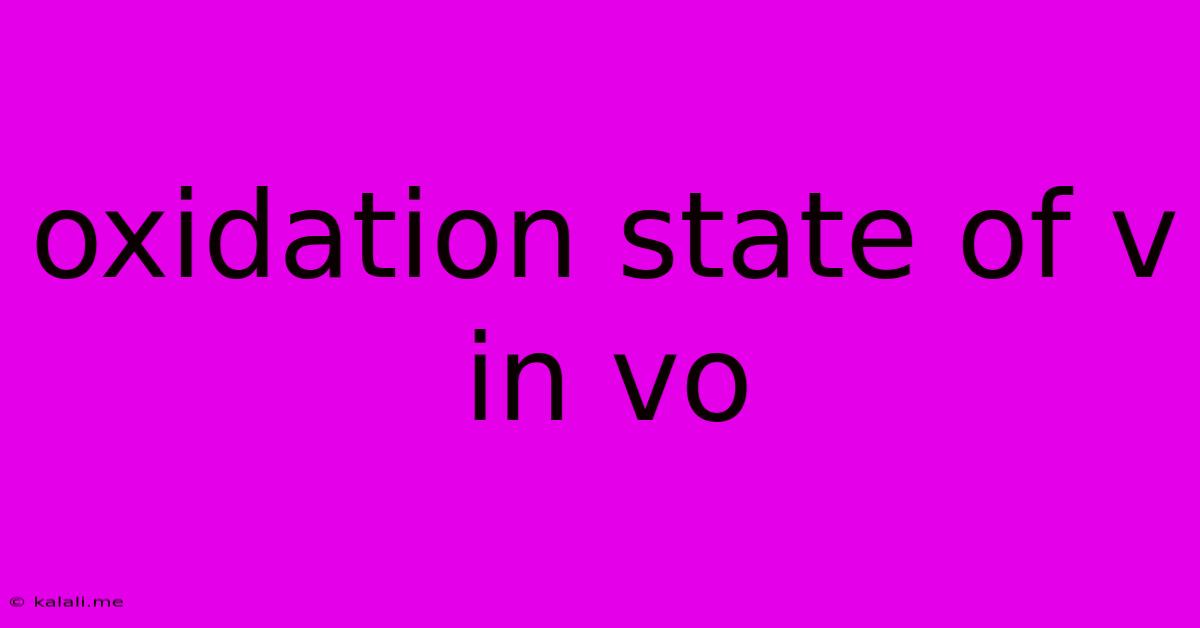Oxidation State Of V In Vo
Kalali
Jun 15, 2025 · 3 min read

Table of Contents
Determining the Oxidation State of V in VO
Determining the oxidation state of vanadium (V) in vanadium monoxide (VO) might seem straightforward, but a deeper understanding requires considering the nature of chemical bonding and electron distribution. This article will explore the methods used to ascertain the oxidation state of V in VO, clarifying any potential misconceptions.
Understanding Oxidation States
The oxidation state, also known as oxidation number, represents the hypothetical charge an atom would have if all bonds to atoms of different elements were 100% ionic. It's a crucial concept in chemistry, helping us predict reactivity and understand redox reactions. While not a true charge, it provides a useful framework for understanding electron distribution within a molecule or ion.
Analyzing VO: A Case Study
Vanadium monoxide (VO) is a compound exhibiting significant covalent character in its bonding. Simply assigning charges based on electronegativity differences doesn't fully capture the reality of the electron distribution. Oxygen (O) is significantly more electronegative than vanadium (V), leading to a polar covalent bond. However, the oxidation state is a formal assignment, not a measure of the actual charge.
Method 1: Considering the Typical Oxidation States of Oxygen
Oxygen typically exhibits an oxidation state of -2 in its compounds, except in peroxides (e.g., H₂O₂) and superoxides. In VO, assuming oxygen maintains its usual -2 oxidation state, we can use a simple algebraic approach:
- Let x be the oxidation state of V.
- The overall charge of VO is neutral (0).
- Therefore, x + (-2) = 0
- Solving for x, we get x = +2
This method suggests that the oxidation state of V in VO is +2.
Method 2: Considering the Electronic Configuration and Bonding
A more sophisticated approach involves examining the electronic configuration of vanadium and the nature of the bonding in VO. Vanadium has an electronic configuration of [Ar] 3d³ 4s². In VO, the bonding involves significant orbital overlap and electron sharing between V and O atoms. While a purely ionic model isn't accurate, the +2 oxidation state for vanadium aligns with the observed properties of the compound.
Addressing Potential Complications and Alternative Interpretations
Some might argue that the covalent nature of the V-O bond complicates assigning a simple oxidation state. However, the oxidation state is a formalism—a useful tool for bookkeeping electrons in redox reactions and predicting reactivity. While the actual charge distribution is more nuanced, the +2 oxidation state provides a consistent and practical representation for vanadium in VO.
Conclusion:
Based on both the conventional approach considering oxygen's usual oxidation state and a more in-depth analysis of the electronic structure and bonding, the oxidation state of vanadium (V) in vanadium monoxide (VO) is +2. This seemingly simple determination highlights the importance of understanding both the practical application of oxidation state and the underlying complexities of chemical bonding. Remember that the oxidation state is a tool for understanding electron transfer and reactivity, not a precise measurement of actual charge on an atom within a molecule.
Latest Posts
Latest Posts
-
How Many Significant Figures Does 500 Have
Jun 15, 2025
-
Least Common Multiple Of 21 And 49
Jun 15, 2025
-
Non Metal Liquid At Room Temperature
Jun 15, 2025
-
Which Of The Following Is Not An Organ System
Jun 15, 2025
-
How To Freeze Formulas In Excel
Jun 15, 2025
Related Post
Thank you for visiting our website which covers about Oxidation State Of V In Vo . We hope the information provided has been useful to you. Feel free to contact us if you have any questions or need further assistance. See you next time and don't miss to bookmark.